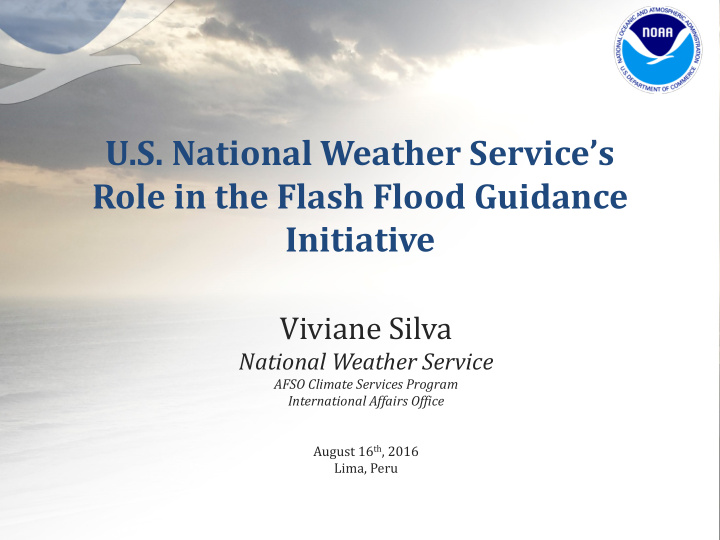



U.S. National Weather Service’s Role in the Flash Flood Guidance Initiative Viviane Silva National Weather Service AFSO Climate Services Program International Affairs Office August 16 th , 2016 Lima, Peru
Global Flash Flood Guidance Initiative • The implementation of Flash Flood Guidance systems globally is an initiative to provide a tool for National Meteorological and Hydrological Services to develop flash flood warnings. • Addresses the need to provide early warnings for flash floods using cooperative regional approaches. 2
The beginning …. Approximately 7,000 people were killed, • 11,000 were missing and approximately 20% of Honduras’ population lost their homes. (Source: Rosario Alfaro) As a result of this catastrophic event, a • Pilot project to design and implement a regional system for flash flood guidance was developed for Central America collaboration between NOAA/ NWS & CPO , – USAID (US Agency for International Development) and HRC (Hydrologic Research Center) Hurricane Mitch October 1998 3
The Central America’s FFGS • First regional FFG system developed • In 2004, this system began operating on a server located in San José, Costa Rica, providing products to support flash flood warnings for all 7 Central America Countries (Belize, Guatemala, Honduras, El Salvador, Nicaragua, Costa Rica and Panama) NWS advancing the science and technology to support the application of early warning systems for flash floods. 4
Establishing a cooperative initiative for the flash flood guidance system with global coverage project • In February 2009, a memorandum of understanding was signed among Hydrologic Research Center (HRC), World Meteorological Organization (WMO), NOAA/National Weather Service (NWS), and United States Agency for International Development (USAID) To work together under a cooperative initiative to implement the FFG system worldwide 5
NOAA/NWS Role within the MOU • NWS is a technical partner and responsible for the following activities: – Provide technical advice for the design, development and operation of the Global FFG – Make available satellite and in-situ rainfall data through the National Weather Service Telecommunication Gateway Note: All NWS activities are subject to the availability of appropriated funds and personnel, and must be in accordance with applicable U.S. laws and regulations.
NWS Role: Data Provider & Technical Expertise Variable Product NOAA/NWS Office Operational Quantitative Global Hydro-Estimator [GHE] NESDIS/Office of Satellite and satellite-derived Precipitation Product Operations [OSPO ] Estimates (QPE) Operational QPE CMORPH - very high spatial Climate Prediction Center [CPC] and temporal resolution estimates from low orbiter satellite microwave observations Operational Snow Areal Extent Interactive Multisensor Snow National Ice Center [NIC] and Ice Mapping System [IMS] Operational Surface Air Global Forecast System (GFS) National Centers for Temperature Environmental Prediction [NCEP] Historical Gauge Rainfall Data National Centers for [Data are used for the systems Environnemental Information development and calibration] (NCEI)
NWS Role: Regional Funding Support In 2011, NWS provided resources to HRC to: • – Update portions of Central America FFGS – Conduct regional training to build long term capacity in the region – Implement an initial FFGS for Pakistan – Conduct an operations workshop in Islamabad FYI: Outside MOU activity • – Most recently, NWS submitted a proposal to USAID for a project to expand and refine early warning systems in Central America and to initiate a Weather-Ready Nations (IDSS) initiative. 8
Thank You! Viviane.Silva@noaa.gov 9
Recommend
More recommend